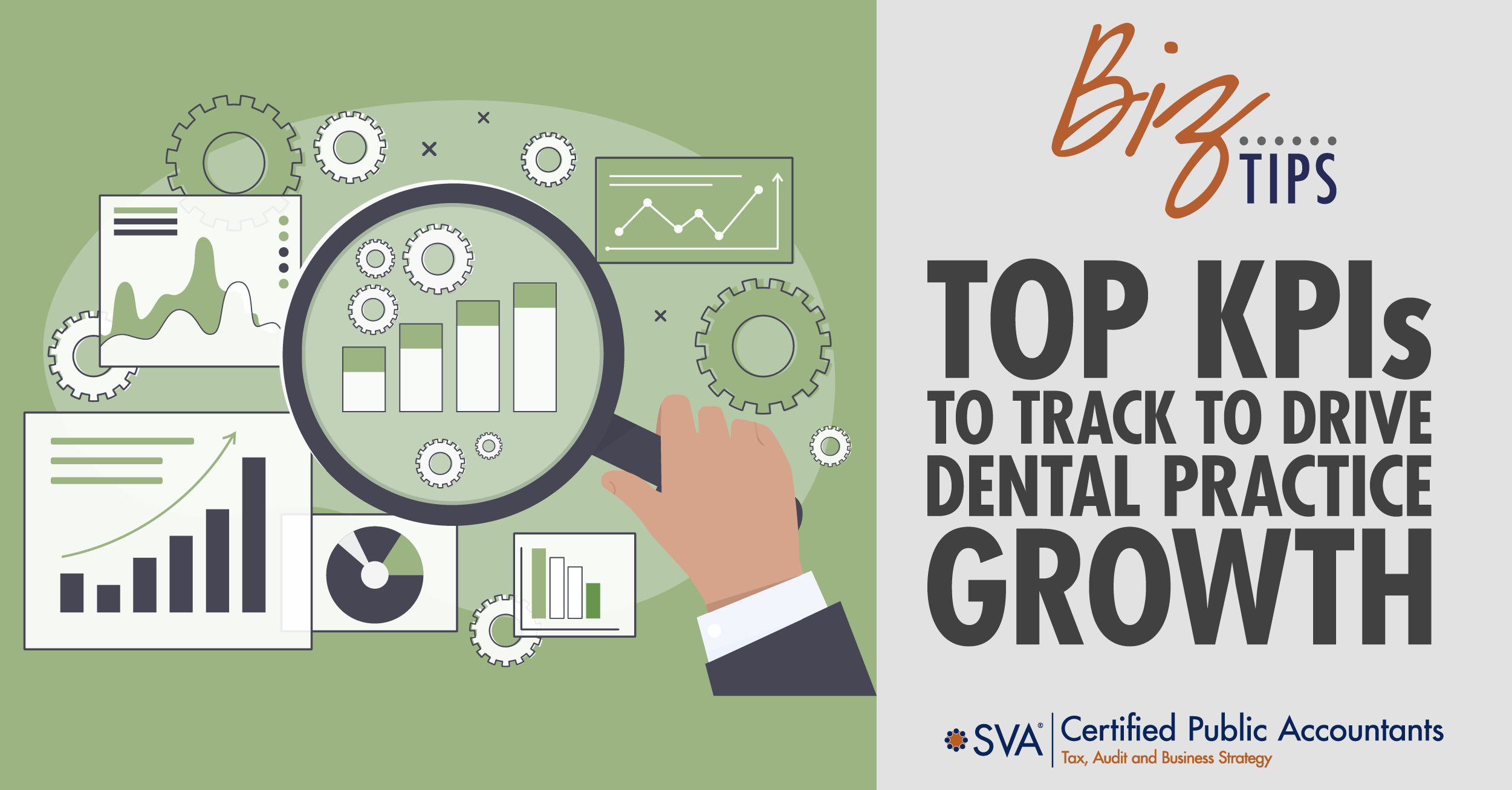Key performance indicators (KPIs) are metrics that can help measure and determine the health of your dental practice. KPIs should support the objectives and goals you have set for your practice, and need to be based on timely, accurate information. KPIs can also provide insight into revenue, costs, and efficiencies.
KPIs should be:
- Accessible
- Accurate Data
- Timely
- Relevant/Insightful
- Adjustable to Different Timelines
Production and Revenue
For an average, successful dental practice of two hygienists, assistants, and office staff, the office production is going to be $1.3 to $1.4 million with collections around 75%. A hygiene production collection goal of $1 million means each hygienist needs a goal of $240,000 to $250,000.
Hygiene Production Ratio
The hygiene production ratio is the production by the hygienist divided by their wages. Our recommended KPI here is a ratio of 3.5 to one. If your ratio is lower than 3.5, take a holistic view of your appointments to determine where you can increase that ratio.
Some things to consider are broken appointments and the length of appointments – if the length is an hour, consider if you can whittle appointments down to 45 or 50 minutes to add in another patient.
Dentist Production Ratio
Dentist production on average is between $850,000 and $950,000. The dentist production ratio is dentist production divided by the hygiene production, and our recommended goal is a ratio of two to one.
For example, if our hygienist produces $500,000, our dentist will need to produce $1 million to meet the two-to-one ratio.
Collection-to-Production Ratio
Collection-to-production ratios are set up as a percentage. It is how much you collect divided by your total production. We have seen the collection rate drop over the last 15 years from 92% in 2008 to 75% now.
If your collection rate is lower than 75%, you may want to consider implementing a dental membership program. These can have a collection rate of more than 85%.
Financial Statement Formatting and Benchmarking
It is important to review your financial statements monthly for timely, accurate, and accessible data to measure your KPIs. We recommend breaking down your statements into categories to more easily track where your expenses are going.
Expense categories:
- Staffing
- Rent
- Dental supplies and laboratory
- Other overhead expenses
- Associate compensation (if applicable)
- Revenue available for professional compensation
As your practice grows, comparing current activity to a prior month, quarter, or year may not be the best comparison. Your practice will have expenses like dental supplies and laboratory costs that directly relate to practice revenue. Measuring these as a percentage of revenue will provide a better benchmark than comparing the actual expenses to the prior year.
| Expense Type |
Ideal Percent of Revenue |
| Staffing |
30% |
| Rent |
6% - 10% |
| Dental Supplies and Laboratory |
3% - 7% |
| Other Overhead Expenses |
15% |
| Revenue Available for Professional Compensation/Associate Compensation (if applicable) |
35% - 38% |
These statistics can tell you how your cost function is doing and provide other insights into your practice. For example, the percentage of revenue in dental supplies and laboratory supplies tends to run between 6% to 7%. If your percentage is drastically lower or higher, it could point out an inventory maintenance problem – inventory levels are too low or too high.
When looking at the percentage of revenue available for professional compensation, it is important to only use professional revenue. Over the past few years, there have been stimulus funds, PPP loans, and employee retention credits that have been counted as revenue. These categories can inflate or deflate your ratios and should not be considered as part of your practice’s professional compensation.
Insurance Contract Considerations
If you are thinking about dropping or adding an insurance contract, there are numerous questions to consider. This also depends on where you are in your practice.
A start-up looking to fill as many appointments as possible probably has different goals than an established practice with more patients than open chair time.
These questions can help you determine the best course of action for your insurance contracts:
| Do You Have Extra Time and Space? |
Do you have open chair time that can accommodate more patients? Also, make sure that your current staff and office hours will be able to handle a potential influx of patients. |
| What is the Reimbursement Rate? |
If a new contract will pay less than what you are currently getting, it may not make sense to switch. |
| Will This New Insurance Bring in More Patients? |
More patients could mean more money, but only if you can handle them without overworking yourself or your staff. |
|
What Are Your Fixed and Variable Costs?
|
Fixed costs (like rent, utilities, and salaries for most of your staff) don't change no matter how many patients you see. Variable costs (like dental supplies and lab fees) go up when you treat more patients. |
| Making Money From New Contracts |
Even if the insurance doesn't pay as much as you'd like (like 65% instead of 75%), you have to remember that you're not spending more on fixed costs, just the variable ones. For example, if you’d like 75% and the insurance only pays 65%, you could still make a 50% profit on the work you do for those patients. |
On the flip side, if your practice is already busy and you don’t have open chair times, adding a new insurance contract is probably not in your best interest, but dropping an existing one may be advantageous.
Determine the ones that pay the least and consider whether it's worth keeping them. If they're paying you less than others, and you have a lot of patients waiting to get in, you could drop the low-paying insurance, allowing you to take in more patients with better-paying plans.
Hiring an Associate
Many dental practice owners wonder when the right time is to hire a new associate.
The first thing to consider is why you may need a new associate – are you trying to grow your practice, cut back on hours, or transition your practice to a new owner?
You also need to consider the current growth trajectory of your practice, active patients, and potential new patients.
Lastly, you need to calculate all the costs associated with a new associate - base pay, bonuses, payroll taxes, and insurance.
Need Help with KPIs?
If you need help determining if and when to hire a new associate, contact our professionals at SVA. We can work with you to determine the best path forward for your dental practice. SVA can also help you create a plan to meet your KPIs.
© 2023 SVA Certified Public Accountants

